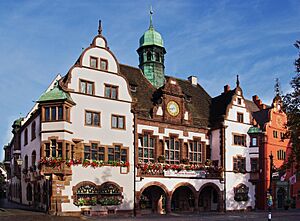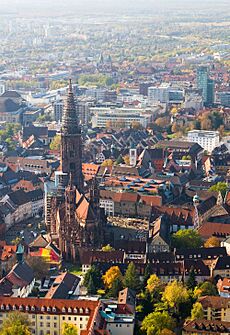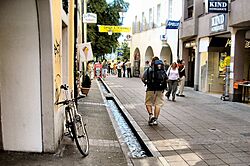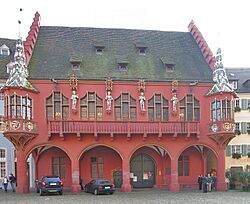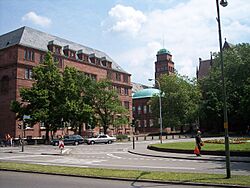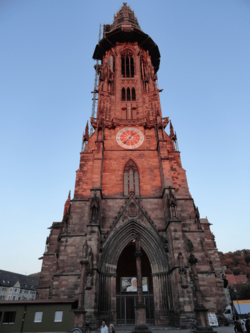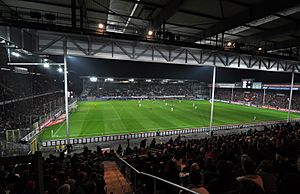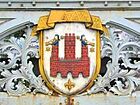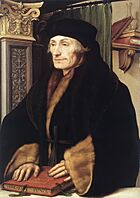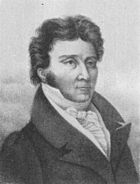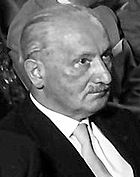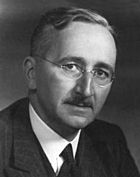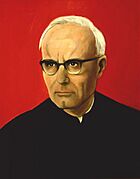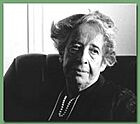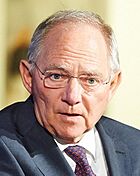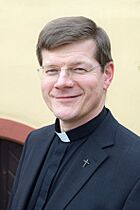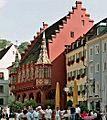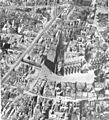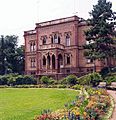Freiburg im Breisgau facts for kids
Quick facts for kids
Freiburg im Breisgau
Friburg im Brisgau (Alemannic)
|
|||
|---|---|---|---|
|
Freiburg Minster
Bächle
Swabian Gate
Historical Merchants' Hall
Aerial view
|
|||
|
|||
| Country | Germany | ||
| State | Baden-Württemberg | ||
| Admin. region | Freiburg | ||
| District | Stadtkreis | ||
| Elevation | 278 m (912 ft) | ||
| Population
(2022-12-31)
|
|||
| • City | 236,140 | ||
| • Urban | 354,500 | ||
| • Metro | 656,753 Oberrhein | ||
| Time zone | CET/CEST (UTC+1/+2) | ||
| Postal codes |
79098–79117
|
||
| Dialling codes | 0761, 07664, 07665 | ||
| Vehicle registration | FR | ||
| Website | www.freiburg.de | ||
Freiburg im Breisgau (often just called Freiburg) is a cool city in Germany. It's the fourth-largest city in the state of Baden-Württemberg. About 236,000 people live here.
Freiburg is in a special spot. It sits at the edge of the famous Black Forest mountains. The Dreisam River flows through the city. It's the southernmost and southwesternmost big city in Germany. This means it's one of the warmest places in the country!
This city is old and full of history. It has a famous university, the University of Freiburg, which started way back in 1457. One of its most famous buildings is the Freiburg Minster. This amazing church was built between 1200 and 1513. People call it a "Gothic architectural masterpiece."
Freiburg's old town has a unique feature: tiny streams called Bächle. These small streams run along almost every street. They get their water from the Dreisam River. The Bächle make the city feel special. Freiburg is also known for being very eco-friendly. It has cool projects like the Vauban district, which is built to be sustainable.
Contents
History of Freiburg
Freiburg was started in 1120 by the House of Zähringen family. They made it a "free market town," which is how it got its name. Frei means "free," and Burg meant a town with some freedom. So, it was a "free town."
The city was in a great location for trade. It was on routes connecting the Mediterranean Sea and the North Sea. By 1200, about 6,000 people lived there. Around this time, they started building the Freiburg Minster cathedral. It began in the Romanesque style and was finished in the Gothic style by 1513.
In 1218, the city's leaders didn't trust their new rulers. They wrote down their rights to protect the city's freedom. Later, in the late 1200s, the citizens had a fight with their lord, Count Egino II. He raised taxes and tried to take away their freedom. The people used catapults to destroy his castle on the Schloßberg hill.
There's an old story that a butcher named Hauri killed the Bishop of Strasbourg in 1299. Because of this, Freiburg had to pay a yearly fine to the count until 1368. Finally, in 1368, Freiburg bought its freedom from the counts! The city then asked the Habsburgs for protection. The Habsburgs let Freiburg keep most of its freedom.
Silver mines in a nearby mountain called Schauinsland made Freiburg very rich. In 1327, Freiburg even made its own coin! This wealth made Freiburg one of the richest cities in Europe. Between the 1200s and 1300s, 8,000 to 9,000 people lived in Freiburg. But by 1460, the silver was running out, and the population dropped to about 6,000.
Freiburg's Growth and Challenges
Even as mining slowed, Freiburg became a center for learning and culture. In 1457, the Albert-Ludwigs-Universität was founded. This is one of Germany's oldest universities. In 1498, a big meeting of leaders, called a Reichstag, was held in Freiburg. In 1520, the city made new laws that were very fair for their time.
Freiburg decided not to join the Protestant Reformation. It became an important center for Catholicism. Sadly, in 1536, people in the city started believing strongly in witchcraft. This led to the city's first witch-hunt. When the Black Plague hit in 1564, killing many people, the witch-hunts got worse. A special plaque on the old city wall remembers where these events happened.
The 1600s, 1700s, and 1800s were tough times for Freiburg. At the start of the Thirty Years' War in 1618, 10,000 to 14,000 people lived there. By the end in 1648, only 2,000 remained. The Battle of Freiburg in 1644 was one of the bloodiest battles of the war.
From 1648 to 1805, Freiburg was often under French control. When it wasn't, it was the main city for the Habsburg lands in southwest Germany. In 1805, Freiburg became part of Baden. In 1827, it became the seat of a Catholic archbishop.
Freiburg in Modern Times
Freiburg was heavily bombed during World War II. In May 1940, German planes accidentally dropped bombs near the railway station. This killed 57 people, including 22 children. Later, on November 27, 1944, over 300 bombers from the RAF Bomber Command destroyed much of the city center. Luckily, the Münster (cathedral) was only slightly damaged. After the war, the city was rebuilt to look like its medieval past.
During World War II, the Nazi government ordered the removal of all Jewish people from Baden, including Freiburg. They were sent to camps in France and then to Auschwitz. To remember these terrible events, there is a special memorial where the city's original synagogue once stood. It was burned down in 1938 during a terrible event called Kristallnacht. Also, small brass plates called 'Stolpersteine' are placed in the pavements outside the homes of victims. These help us remember the people who suffered.
The French Army occupied Freiburg in 1945. Freiburg became the capital of the German state of South Baden. In 1952, it joined to form Baden-Württemberg. The French Army stayed in Freiburg until 1991.
Today, where the French Army base used to be, there's a new neighborhood called Vauban. It started in the late 1990s as a "sustainable model district." Many homes there use solar power.
Points of Interest
Freiburg is a popular place for tourism. This is because of its beautiful scenery, warm climate, and easy access to the Black Forest. In 2010, Freiburg was even named the European City of the Year for its amazing sustainable urbanism efforts.
You can take the longest cable car ride in Germany here! It's 3.6 kilometers (2.2 miles) long and goes from Günterstal up to a mountain called Schauinsland.
The city has a cool system of small gutters called Freiburg Bächle. These Bächle flow with water from the Dreisam River. Long ago, they helped fight fires and watered animals. Today, they keep the air cool in summer and make a nice gurgling sound. There's a fun legend: if you accidentally step into a Bächle, you'll marry someone from Freiburg!
The Augustinerplatz is a main square in the old city. It used to be an old monastery, but now it's a popular spot for young people. It has restaurants and bars, including a local brewery with a Biergarten (beer garden).
The Münsterplatz is Freiburg's biggest square. A farmers' market is held here almost every day. This is where you'll find the Münster, the beautiful Gothic cathedral.
The Historical Merchants' Hall (Historisches Kaufhaus) is a stunning Late Gothic building on the Münsterplatz. Built between 1520 and 1530, it was once a hub for business. Its front is decorated with statues and the coat of arms of four old emperors.
The Altes Rathaus, or old city hall, was finished in 1559. It has a colorful painted front. The Platz der alten Synagoge ("Old Synagogue Square") is another important square. It's where a synagogue stood until it was destroyed in 1938. Zum Roten Bären, the oldest hotel in Germany, is also in Freiburg.
The Siegesdenkmal, or victory monument, celebrates a German victory in 1871. It's a well-known meeting spot in the city.
East of the city center, the Schlossberg hill offers amazing views. The old castle there was taken down in the 1740s, but the hill is still important. Today, a funicular railway takes you from the city center up the hill.
Other cool places to visit include the Archaeology Colombischlössle Museum.
Popular Sights in Freiburg
- Arboretum Freiburg-Günterstal: A garden with many different trees.
- Freiburg Botanic Garden: A beautiful plant garden.
- University of Freiburg: One of Germany's oldest universities.
- University Library Freiburg: A modern and newly renovated library.
- The Whale House: A unique building.
- Augustiner Museum: A museum in an old monastery.
- Freiburg Munster: The famous medieval cathedral.
- Schauinsland: A mountain with great views, reached by cable car.
- Schlossberg: A hill overlooking the city.
- Colombischlössle Archeological Museum: A museum about history and old discoveries.
- Green spaces: Parks and natural areas.
- Vauban, Freiburg: A special eco-friendly neighborhood.
- Cobblestone mosaics: Artful designs on the city's streets.
- Kybfelsen Castle: Ruins of an old castle.
Geography and Climate
Freiburg is surrounded by nature. To the east are the Black Forest mountains like Rosskopf. To the south are Schönberg and Tuniberg. The Kaiserstuhl hills are to the west.
Freiburg's Weather
Freiburg has a mild temperate oceanic climate. This means it has warm summers and mild winters. July and August are usually the warmest months in Germany. It gets more rain than some other areas nearby. The city is close to the Kaiserstuhl, a volcanic hill region. This area is one of the warmest places in Germany and is great for growing grapes for wine.
| Climate data for Freiburg 1991–2020, sunshine 2018–2022, extremes 1949–present | |||||||||||||
|---|---|---|---|---|---|---|---|---|---|---|---|---|---|
| Month | Jan | Feb | Mar | Apr | May | Jun | Jul | Aug | Sep | Oct | Nov | Dec | Year |
| Record high °C (°F) | 20.8 (69.4) |
21.9 (71.4) |
25.7 (78.3) |
30.0 (86.0) |
33.7 (92.7) |
36.5 (97.7) |
38.3 (100.9) |
40.2 (104.4) |
33.9 (93.0) |
30.8 (87.4) |
24.2 (75.6) |
21.7 (71.1) |
40.2 (104.4) |
| Mean daily maximum °C (°F) | 5.6 (42.1) |
7.4 (45.3) |
12.1 (53.8) |
16.6 (61.9) |
20.6 (69.1) |
24.3 (75.7) |
26.4 (79.5) |
26.1 (79.0) |
21.3 (70.3) |
15.8 (60.4) |
9.6 (49.3) |
6.4 (43.5) |
16.0 (60.8) |
| Daily mean °C (°F) | 3.1 (37.6) |
4.1 (39.4) |
7.7 (45.9) |
11.3 (52.3) |
15.4 (59.7) |
19.0 (66.2) |
21.0 (69.8) |
20.7 (69.3) |
16.4 (61.5) |
11.9 (53.4) |
6.8 (44.2) |
4.0 (39.2) |
11.8 (53.2) |
| Mean daily minimum °C (°F) | 0.5 (32.9) |
0.7 (33.3) |
3.3 (37.9) |
6.0 (42.8) |
10.2 (50.4) |
13.7 (56.7) |
15.6 (60.1) |
15.3 (59.5) |
11.4 (52.5) |
8.0 (46.4) |
3.9 (39.0) |
1.4 (34.5) |
7.5 (45.5) |
| Record low °C (°F) | −16.7 (1.9) |
−14 (7) |
−5.7 (21.7) |
0.1 (32.2) |
2.4 (36.3) |
6.9 (44.4) |
8.8 (47.8) |
7.2 (45.0) |
4.7 (40.5) |
−1.8 (28.8) |
−6.1 (21.0) |
−15.5 (4.1) |
−16.7 (1.9) |
| Average precipitation mm (inches) | 42.8 (1.69) |
45.5 (1.79) |
49.9 (1.96) |
62.3 (2.45) |
95.4 (3.76) |
83.8 (3.30) |
84.5 (3.33) |
75.2 (2.96) |
70.6 (2.78) |
78.7 (3.10) |
68.7 (2.70) |
61.9 (2.44) |
819.4 (32.26) |
| Average snowfall cm (inches) | 1.0 (0.4) |
0.51 (0.2) |
0.0 (0.0) |
0.0 (0.0) |
0.0 (0.0) |
0.0 (0.0) |
0.0 (0.0) |
0.0 (0.0) |
0.0 (0.0) |
0.0 (0.0) |
0.25 (0.1) |
0.76 (0.3) |
1.3 (0.5) |
| Average rainy days (≥ 0.1 mm) | 14.8 | 13.3 | 14.2 | 13.3 | 15.1 | 14.2 | 13.8 | 13.6 | 11.8 | 14.7 | 15.2 | 16.2 | 170.2 |
| Mean monthly sunshine hours | 62 | 115 | 161 | 207 | 239 | 265 | 300 | 261 | 214 | 123 | 80 | 71 | 2,098 |
| Mean daily sunshine hours | 1.7 | 3.4 | 4.9 | 6.2 | 6.6 | 8.2 | 10.1 | 9.0 | 7.1 | 4.2 | 2.1 | 2.4 | 5.7 |
| Average ultraviolet index | 1 | 2 | 3 | 5 | 6 | 8 | 8 | 7 | 6 | 5 | 3 | 1 | 5 |
| Source: Weatheronline.de, Meteociel.fr, weather-atlas, and wetterdienst | |||||||||||||
| Largest groups of foreigners by country of origin | |
| Nationality | Population (2022) |
|---|---|
| 3,211 | |
| 2,825 | |
| 2,603 | |
| 1,992 | |
| 1,761 | |
| 1,652 | |
| 1,574 | |
| 1,382 | |
| 1,235 | |
| 1,124 | |
Education and Learning
Freiburg is a big center for learning and research. Many smart people and Nobel Laureates have lived and worked here.
The city has one of Germany's oldest and most famous universities, the Albert Ludwig University of Freiburg. It also has a large medical center. Many important thinkers have been part of this university. It's known as one of Europe's top places for research and teaching.
Freiburg is also home to many other schools and research places. These include the Freiburg University of Education and the Freiburg Music Academy. There are also several Max Planck and Fraunhofer institutes. These are big research organizations in Germany.
Students from other countries can study in Freiburg too. The IES Abroad program lets students learn about the EU. They also have a program about Freiburg's famous green lifestyle.
Freiburg also has a special French-German high school. It's called the DFG / LFA Freiburg. The UWC Robert Bosch College is also here. It's one of only eighteen United World Colleges around the world.
Religion in Freiburg
Freiburg was mostly Catholic for a long time. This was because it belonged to Austria until 1805. In 1821, Freiburg became the main city for the Roman Catholic Archdiocese of Freiburg. The main church for the bishop is the Freiburg Minster.
Saint George is one of Freiburg's patron saints. You can see his cross on the city's flag. Many artworks in the Minster and museums show these saints.
After 1805, more Protestants moved to Freiburg. Today, there are also other Christian churches in the city. Some old monastery churches are used by different groups. There are also Greek, Serbian, Russian, and Romanian Orthodox churches.
Jewish Community in Freiburg
Jewish people have lived in Freiburg for a very long time. They had an official community by 1230. However, in 1349, during the time of the plague, many Jewish people faced unfair accusations. This led to a difficult time for the community. In 1401, the city council even banned all Jewish people from Freiburg for a long time.
It wasn't until 1809 that Jewish people were allowed to live in the city again. They started a new community in 1836.
During the Kristallnacht in 1938, the synagogue in Freiburg was burned down. Many Jewish homes and shops were destroyed. In 1940, the remaining Jewish people from Freiburg were forced to leave. They were sent to camps where many lost their lives.
Today, memorials help us remember these events. A special fountain marks where the synagogue once stood. Small brass plates, called 'Stolpersteine', are placed in the sidewalks. Each one remembers a person who suffered during that time.
Getting Around Freiburg
Freiburg has a large pedestrian zone in its city center. This means no cars are allowed there! The city also has a great public transport system. It's run by VAG Freiburg.
The main part of the transport system is the Freiburg tramway network. Buses help connect other areas. The tram system is very popular. Tickets are affordable, and they let you travel anywhere in the city. If you have a ticket for a concert or sports event, it's also valid for public transport! Most people in Freiburg live close to a tram stop.
Freiburg is on a main railway line that connects to big cities in Germany and Europe. The Freiburg Hauptbahnhof (main train station) has frequent trains. Other train lines go into the Black Forest and to Breisach.
The city is also served by the A5 motorway, which connects to Frankfurt and Basel.
For air travel, the EuroAirport Basel-Mulhouse-Freiburg is about 70 kilometers (43 miles) south. The Karlsruhe/Baden-Baden Airport is about 100 kilometers (62 miles) north. There's also a small airfield in Freiburg for private planes.
Many Freiburg residents use car share websites like BlaBlaCar. This helps reduce the number of cars on the road. Because of all these transport options, more people walk, cycle, or use public transport.
Sports in Freiburg
Freiburg has a rich sports history. The Freiburger FC football team won the German championship in 1907. For a long time, no other team won a national title. But in 2022, the Eisvögel USC Freiburg women's basketball team won the top league title!
Freiburg is home to the football club SC Freiburg. They play at the Europa-Park Stadion. The men's team has been in Germany's top football leagues since 1978. They are known for their stable leadership. The women's team of SC Freiburg also plays in the top women's league.
The city also has the EHC Freiburg ice hockey team. They play at the Franz-Siegel Halle. The EHC Freiburg team, known as "the wolves," played in Germany's highest ice hockey league in 2003/2004.
There's also the RC Freiburg Rugby union team. They play in the second Bundesliga South. Other teams include the volleyball men's team of the FT 1844 Freiburg and the handball women's team of the HSG Freiburg.
From 1925 to 1984, the ADAC Schauinsland Races took place on an old logging track. This course is still sometimes used for racing events.
Culture in Freiburg
The Union for Aromanian Language and Culture was founded in Freiburg in 1985. This group helps keep the Aromanian language and culture alive.
Local News
The Badische Zeitung is the main local newspaper in Freiburg. It covers news from the Black Forest region.
Twin Towns and Sister Cities
Freiburg im Breisgau has many twin towns and sister cities around the world:
- Besançon, France (1959)
- Granada, Spain (1991)
- Guildford, United Kingdom (1979)
- Innsbruck, Austria (1963)
- Isfahan, Iran (2000)
- Lviv, Ukraine (1989)
- Madison, United States (1987)
- Matsuyama, Japan (1988)
- Padua, Italy (1967)
- Suwon, South Korea (2015)
- Tel Aviv, Israel (2015)
- Wiwilí de Jinotega, Nicaragua (2015)
City Symbols
Freiburg's coat of arms is a red cross on a white background. This is the St George's Cross. Saint George is the city's patron saint. The cross is also on the city's flag, which has been used since about 1368. It looks just like the flag of England!
The city also has a special seal. You can see it in a few places in the city center. It shows a castle-like building with three towers. This building is a waterworks facility called the Wasserschlössle.
Notable People from Freiburg
Historical Figures (Before 1800s)
- Desiderius Erasmus (1466–1536): A famous Dutch thinker and theologian.
- Berthold Schwarz (c. 1310–1388): A legendary alchemist who brought gunpowder to Germany.
- Martin Waldseemüller (c.1470–1520): A Renaissance mapmaker.
- Joseph von Auffenberg (1798–1857): A playwright and poet.
- Johann Nepomuk Locherer (1773–1837): A Catholic priest and professor.
- Karl von Rotteck (1775–1840): A political activist and historian.
- Heinrich Schreiber (1793–1872): A Catholic theologian and historian.
People from the 1800s
- Sepp Allgeier (1895–1968): A cinematographer.
- Walter Benjamin (1892–1940): A literary critic and philosopher.
- Alfred Döblin (1878–1957): A physician and novelist.
- Barney Dreyfuss (1865–1932): A baseball entrepreneur.
- Walter Eucken (1891–1950): An economist.
- Arnold Fanck (1889–1974): A film director.
- Adolf Furtwangler (1853–1907): An archaeologist and art historian.
- Friedrich von Hayek (1899–1992): A famous economist and philosopher, Nobel Prize winner.
- Martin Heidegger (1889–1976): A well-known philosopher.
- Edmund Husserl (1859–1938): A philosopher who created phenomenology.
- Hermann Staudinger (1881–1965): A Nobel Prize winner in chemistry.
- Edith Stein (1891–1942): A nun and Catholic saint.
- Otto Heinrich Warburg (1883–1970): A Nobel Prize winner in medicine.
- Max Weber (1864–1920): A famous sociologist.
- August Weismann (1834–1914): An evolutionary biologist.
- Joseph Wirth (1879–1956): A politician and former chancellor.
- Engelbert Zaschka (1895–1955): An inventor and helicopter pioneer.
People from the 1900s
- Hannah Arendt (1906–1975): A political theorist.
- Nikolaus Brender (born 1949): A journalist.
- Stephan Burger (born 1962): The current Catholic Archbishop of Freiburg.
- Mohamed Dräger (born 1996): A professional footballer.
- Anna Ewers (born 1993): A fashion model.
- Heinrich Haussler (born 1984): A professional cyclist.
- Dany Heatley (born 1981): A former professional ice hockey player.
- Thomas Hengelbrock (born 1958): A violinist and conductor.
- Joachim Löw (born 1960): The coach of the Germany national football team for many years.
- Karl Rahner SJ (1904–1984): An influential Catholic theologian.
- Dieter Salomon (born 1960): A politician and former Mayor of Freiburg.
- Wolfgang Schäuble (1942–2023): A well-known politician.
- Til Schweiger (born 1963): A famous actor and director.
- Klaus Tschira (1940–2015): An entrepreneur.
- Joana Zimmer (born 1979): A pop singer.
Images for kids
See also
 In Spanish: Friburgo de Brisgovia para niños
In Spanish: Friburgo de Brisgovia para niños









